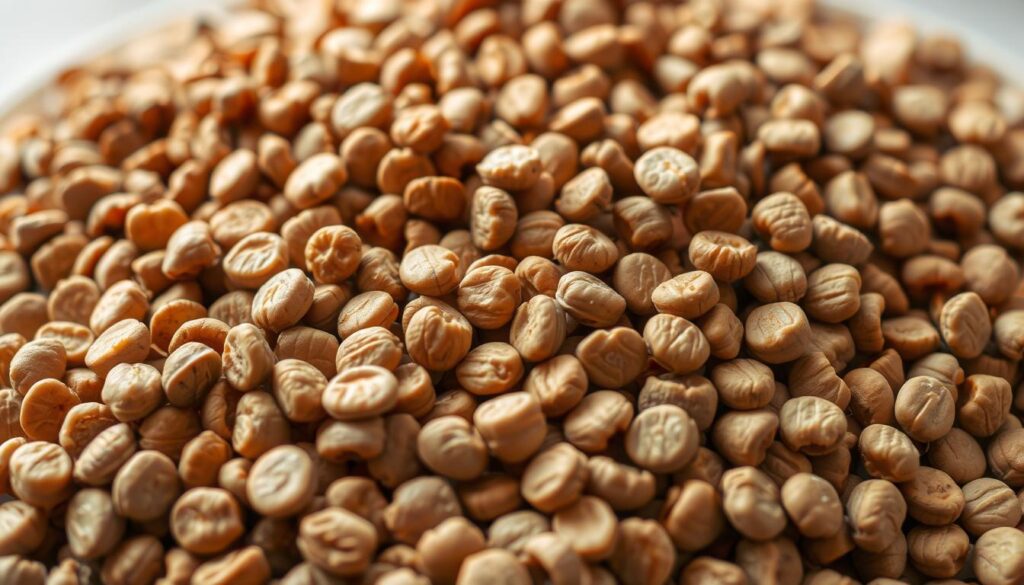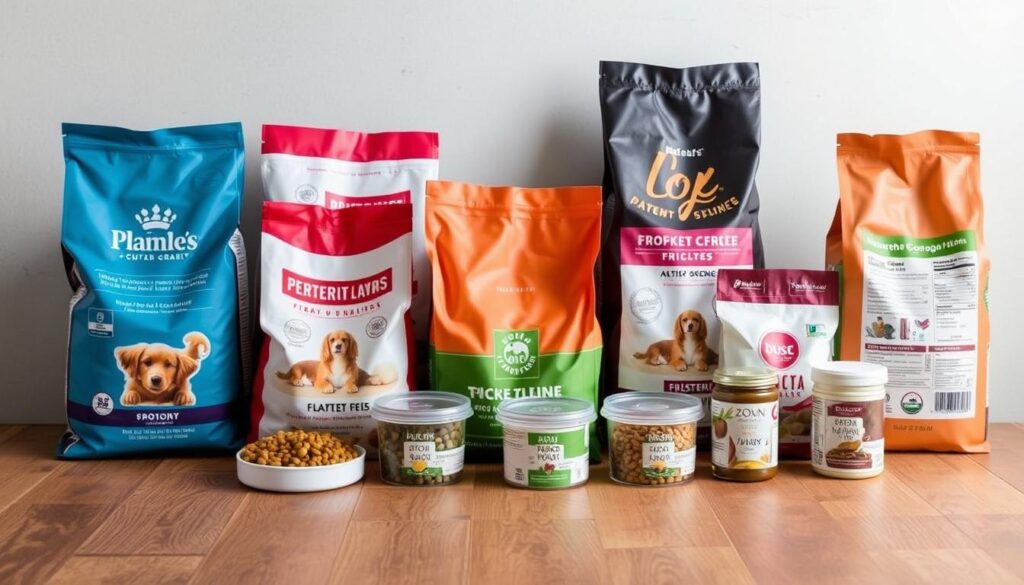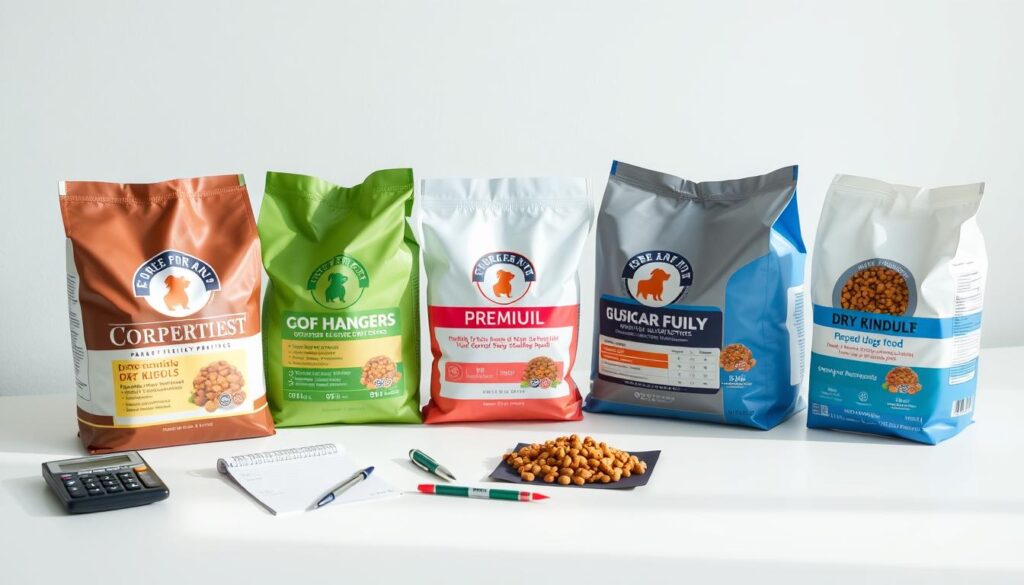As a dog owner, you want the best for your pet and to stay within your budget. Dry dog food is a common choice. But is it right for your furry friend? You might think it’s good because it’s affordable and easy to use.

Dry dog food has many benefits, like being good for your dog and easy to store. When looking at dry dog food, think about its nutrition, cost, and if it meets your dog’s needs. It’s a key choice for affordable pet food.
Introduction to Dry Dog Food
Exploring dry dog food helps you make a smart choice for your dog’s diet. You’ll learn about its good points and downsides, including its role as a popular pet food.
Key Takeaways
- Dry dog food is a popular and convenient option for dog owners.
- It offers a range of nutritional benefits and storage advantages.
- Dry dog food can be a cost-effective choice for dog owners.
- It’s essential to evaluate the nutritional value and suitability of dry dog food for your dog’s needs.
- Considering dry dog food as an affordable pet food option can help you make an informed decision about your dog’s nutrition.
Understanding the Basics of Dry Dog Food
Choosing the right dry food for your dog starts with knowing what it is. Dry dog food combines proteins, carbs, and fats. Look for food that’s affordable and meets your dog’s nutritional needs.
It’s key to understand dry dog food to make a good choice for your dog. The making process involves mixing, extruding, and baking. Quality matters, so pick a trusted brand that fits your dog’s needs.
Key Ingredients and Their Purposes
Ingredients in dry dog food are crucial for its nutritional value. Common ones include chicken, beef, and lamb for protein. Carbs like corn and rice provide energy and support health.

Manufacturing Process and Quality Standards
The making of dry dog food involves mixing, extruding, and baking. Quality is checked by groups like the Association of American Feed Control Officials (AAFCO) and the National Research Council (NRC). They ensure the food is safe and meets dogs’ needs.
Knowing about dry dog food helps you pick a good, affordable option. Always choose a reputable brand and talk to your vet for the best food for your dog.
The Cost Analysis of Dry Dog Food
As a dog owner, you want to give your pet the best nutrition without spending too much. Dry dog food prices vary a lot. This depends on the brand, quality, and your dog’s size. It’s key to compare costs to choose wisely.
A budget-friendly pet nutrition plan means picking a quality dry dog food that’s affordable. Look for dry dog food that vets or animal nutritionists recommend. These foods are balanced and might save you money in the long run.
Here are some tips for a cost analysis of dry dog food:
- Compare prices of different brands and types of dry dog food
- Consider the nutritional value and shelf life of the product
- Look for products that offer discounts or promotions
- Consult with a veterinarian or animal nutritionist for recommendations

By using these tips and doing a detailed cost analysis, you can find a budget-friendly pet nutrition plan. Always put your dog’s health first when choosing their food. If you have questions, talk to a vet or animal nutritionist.
Nutritional Value of Dry Dog Food
Choosing the right food for your dog is key. Nutritional value is a big part of that. Dry dog food is easy and affordable, but it’s important to know its benefits and how it stacks up against wet food. The debate often focuses on nutritional value, with each side having its own strengths.
A quality dry dog food should have proteins, carbs, fats, vitamins, and minerals. It’s convenient, affordable, and lasts a long time. But, picking the right dry food for your dog is crucial. Consider their age, breed, and health when making your choice.
- Protein sources, such as chicken or salmon
- Complex carbohydrates, such as brown rice or sweet potatoes
- Essential vitamins and minerals, such as vitamin D and calcium
Knowing the nutritional value of dry dog food helps you pick a good one. This way, you can ensure your dog gets the nutrients they need to stay healthy.
Storage Benefits and Shelf Life Advantages
Dry dog food has a long shelf life and is easy to store. As a dog owner, you can keep dry dog food for months without needing the fridge. Most dry dog foods stay good for 12-18 months, thanks to how they’re made and packaged.
There are many storage benefits to dry dog food. For example, buying it in bulk can save you money. Plus, it’s less likely to spoil, so you can keep it longer without worry.
Here are some tips for storing dry dog food:
- Keep it in a cool, dry spot.
- Stay away from moisture and humidity.
- Use an airtight container to store it.
By following these tips, your dry dog food will stay fresh and healthy for your dog. The storage benefits and long shelf life of dry dog food make it a great choice for many dog owners.
Is Dry Food a Suitable and Affordable Option for Dog Owners?
Choosing the right food for your dog is key. Dry dog food is popular for its ease and cost. A comparative value assessment of dry dog food versus other options can guide your choice.
Dry dog food is cost-effective. There are many brands and formulas to choose from. It’s also easy to store and serve.
Cost per Serving Breakdown
To see if dry dog food is worth it, calculate the cost per serving. Divide the total cost by the number of servings. Comparing different brands can help you find the best deal.
Long-term Financial Benefits
Dry dog food can save money in the long run. Choosing a cost-effective dog food can prevent health issues and vet bills. A comparative value assessment can help you decide what’s best for your dog.
Comparative Value Assessment
When looking at dry dog food, consider its nutritional value and ingredients. A comparative value assessment of different brands can help you find the best fit for your dog’s needs and budget. This way, you can give your dog the nutrition they need while saving money.
Health Considerations When Choosing Dry Food
When picking the best dry food for dogs, think about their health needs. Different dogs need different foods, especially if they have health issues or allergies. Consider your dog’s age, breed, and size to find the right dry dog food.
Some dogs need special diets because of health problems or allergies. It’s important to talk to your vet to find the right food. They can help pick a dry dog food that fits your dog’s health needs and gives them the nutrients they need.
Here are some things to think about when choosing a dry dog food:
- Nutritional content: Look for a dry dog food that provides a balanced mix of protein, fat, and carbohydrates.
- Ingredient quality: Choose a dry dog food made with high-quality ingredients that are easy to digest.
- Manufacturing process: Opt for a dry dog food that is manufactured using a high-quality process to ensure the nutrients are preserved.
By considering these factors and your dog’s unique health needs, you can find the best dry food. This food will meet their nutritional needs and help them stay healthy and happy.
Comparing Dry Food to Other Feeding Options
As a dog owner, you have many feeding options to choose from. These include dry food, wet food, raw diets, and mixed feeding. Each has its own benefits and drawbacks. It’s important to think about what’s best for your dog’s needs and likes.
Dry food is often cheaper and easier to store. But, wet food has more moisture and protein. Raw diet alternatives offer a natural diet but can be pricey and need careful handling.
Mixed feeding lets you mix different foods for a balanced diet. Some owners mix dry and wet food or add raw ingredients. This way, you can tailor your dog’s diet to their needs.
- Dry food vs wet food cost comparison: Dry food is often more affordable, but wet food can provide more nutritional value.
- Raw diet alternatives: Offer a more natural and nutrient-rich diet, but can be more expensive and require careful handling.
- Mixed feeding approaches: Provide flexibility and can help ensure a balanced diet, but require careful planning and monitoring.
The right food for your dog depends on their needs, likes, and health. By weighing the pros and cons of each option and talking to your vet, you can choose the best diet for your dog.
Tips for Choosing Budget-Friendly Quality Dry Food
Choosing the right dry food for your dog on a budget can be tricky. You want it to be nutritious and affordable. Look for affordable pet food that’s packed with nutrients and made from quality ingredients.
Reading labels is key to making a good choice. Look for a brand comparison to see what each product offers. Check the protein, vitamins, and minerals. Also, watch out for fillers or by-products.
Buying in bulk can save you money. Many brands offer discounts for large orders. Also, comparing brands can help you find the best deal. Here are some tips:
- Compare prices: Research different brands and compare their prices to find the most affordable option.
- Check ingredients: Look for brands that use high-quality ingredients and avoid fillers or by-products.
- Read reviews: Check online reviews from other pet owners to see how their dogs have responded to the food.
By following these tips and comparing brands, you can find quality dry food that’s easy on your wallet. Always put your dog’s health first. If you have questions, talk to your vet about your dog’s diet.
Common Concerns About Dry Dog Food
Thinking about dry dog food for your pet? You might have some worries. The benefits of dry dog food include its ease of use. Yet, some owners fret about allergies or stomach problems. It’s key to pick a top-notch dry dog food that fits your dog’s dietary needs.
When picking a dry dog food, seek advice from your vet or trusted pet food makers. They can guide you through the choices. They’ll help you find the best food for your dog’s age, breed, and health. Some common worries about dry dog food are:
- Potential for allergies or sensitivities
- Digestive issues, such as constipation or diarrhea
- Nutritional deficiencies, if the food is not well-balanced
To lower the chance of bad reactions, start with small amounts of new food. Watch how your dog reacts. With the right dry dog food recommendations and patience, your dog can do well on dry food. They’ll get to enjoy the benefits of dry dog food.
Making the Transition to Dry Food
Switching your dog to dry dog food needs a gradual approach to avoid upset stomachs. Start by mixing a bit of dry food with their usual diet. Then, slowly add more dry food over time. This helps their stomach get used to the new food, reducing bad reactions.
It’s key to introduce dry food gradually for a smooth change. Begin by adding 25% of dry food to their diet and increase it a bit every few days. Keep an eye on how they react to the new food. Watch for signs like diarrhea or vomiting.
Here are some tips for a smooth transition:
- Start with a small amount of dry food and gradually increase the amount
- Monitor your dog’s response to the new food
- Be patient and allow your dog’s digestive system to adjust
By using these gradual steps, you can safely and effectively switch your dog to dry food. This ensures they get the nutrients they need to stay healthy.
Conclusion: Making an Informed Decision for Your Dog’s Nutrition
When exploring dry dog food, remember your dog’s health is key. Knowing the nutritional value, cost, and storage of dry food helps. This way, you can choose what’s best for your dog and your wallet.
Talk to your vet to pick the right dry dog food for your dog. A balanced diet and the right amount of food keep your dog healthy. Every dog is different, so you might need to try a few options to find the best one.
Choosing between dry dog food and other options depends on your dog’s needs, your budget, and what you prefer. Being well-informed and flexible lets you give your dog the nutrition they need. This way, you can enjoy a long, happy life together.
FAQ
What constitutes dry dog food?
Dry dog food is a mix of proteins, carbs, and fats. It’s made by mixing, extruding, and baking these ingredients into a kibble.
What are the common ingredients in dry dog food and their purposes?
Dry dog food includes proteins like chicken or beef, carbs like grains, fats, and vitamins. These ingredients help provide a balanced diet for your dog.
How does the manufacturing process and quality standards impact dry dog food?
The quality of dry dog food varies by manufacturer. Reputable brands follow strict standards for safety and nutrition. It’s key to pick a food that fits your dog’s needs.
How does the cost of dry dog food compare to other feeding options?
Dry dog food is often cheaper than wet food or raw diets. Prices vary by brand and dog size. It’s a budget-friendly choice for many.
What essential nutrients does dry dog food provide?
Good dry dog food offers proteins, carbs, fats, and vitamins. The exact mix varies by brand. Always check the labels to ensure it meets your dog’s needs.
What are the storage benefits and shelf life advantages of dry dog food?
Dry dog food lasts long and is easy to store. It has a shelf life of 12-18 months and doesn’t need refrigeration. This makes it a convenient and cost-effective option.
How does the cost per serving of dry dog food compare to other feeding options?
Dry dog food is often cheaper per serving than wet food or raw diets. It can save money on vet bills and other health expenses in the long run.
What health considerations should I keep in mind when choosing a dry dog food?
Consider your dog’s health needs, like allergies or medical conditions. Some dogs need special diets. Always consult with your vet to ensure the food meets your dog’s nutritional needs.
How does dry dog food compare to other feeding options, such as wet food and raw diets?
Each option has its pros and cons, including cost, nutrition, and convenience. Dry food is cost-effective and convenient. Wet food and raw diets offer different benefits. Choose what best fits your dog’s needs and your lifestyle.
How can I effectively read dry dog food labels to choose a budget-friendly, high-quality option?
Reading labels is key to finding a quality, affordable dry dog food. Look for the ingredient list, nutrient info, and quality seals. Buying in bulk and comparing brands can also help you save money.
What are some common concerns about dry dog food, and how can I address them?
Concerns include allergies, digestive issues, or nutritional deficiencies. Choose a high-quality food that meets your dog’s needs. Monitor their response and consult your vet if needed.
How can I make a smooth transition to feeding my dog dry food?
Transitioning to dry food should be gradual to avoid digestive upset. Start by mixing it with their current food, increasing the dry food ratio slowly. Watch for any issues and be ready to adjust as needed.
